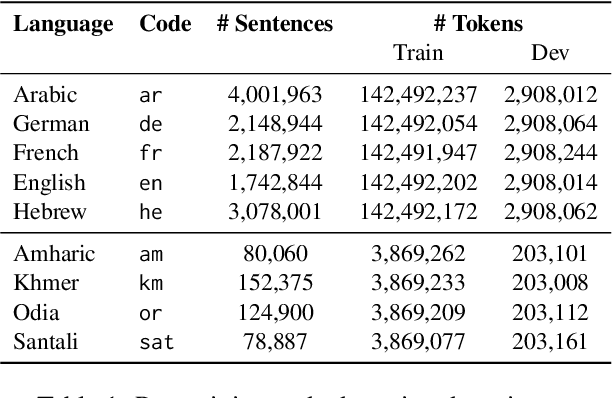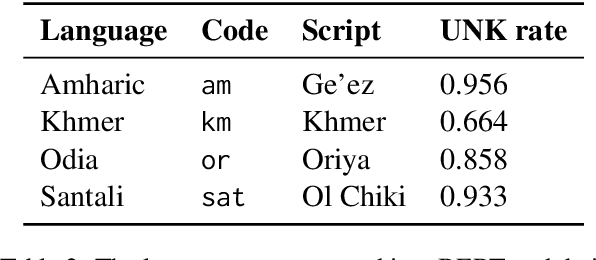Marius Mosbach
LMEnt: A Suite for Analyzing Knowledge in Language Models from Pretraining Data to Representations
Sep 03, 2025Abstract:Language models (LMs) increasingly drive real-world applications that require world knowledge. However, the internal processes through which models turn data into representations of knowledge and beliefs about the world, are poorly understood. Insights into these processes could pave the way for developing LMs with knowledge representations that are more consistent, robust, and complete. To facilitate studying these questions, we present LMEnt, a suite for analyzing knowledge acquisition in LMs during pretraining. LMEnt introduces: (1) a knowledge-rich pretraining corpus, fully annotated with entity mentions, based on Wikipedia, (2) an entity-based retrieval method over pretraining data that outperforms previous approaches by as much as 80.4%, and (3) 12 pretrained models with up to 1B parameters and 4K intermediate checkpoints, with comparable performance to popular open-sourced models on knowledge benchmarks. Together, these resources provide a controlled environment for analyzing connections between entity mentions in pretraining and downstream performance, and the effects of causal interventions in pretraining data. We show the utility of LMEnt by studying knowledge acquisition across checkpoints, finding that fact frequency is key, but does not fully explain learning trends. We release LMEnt to support studies of knowledge in LMs, including knowledge representations, plasticity, editing, attribution, and learning dynamics.
Build the web for agents, not agents for the web
Jun 12, 2025Abstract:Recent advancements in Large Language Models (LLMs) and multimodal counterparts have spurred significant interest in developing web agents -- AI systems capable of autonomously navigating and completing tasks within web environments. While holding tremendous promise for automating complex web interactions, current approaches face substantial challenges due to the fundamental mismatch between human-designed interfaces and LLM capabilities. Current methods struggle with the inherent complexity of web inputs, whether processing massive DOM trees, relying on screenshots augmented with additional information, or bypassing the user interface entirely through API interactions. This position paper advocates for a paradigm shift in web agent research: rather than forcing web agents to adapt to interfaces designed for humans, we should develop a new interaction paradigm specifically optimized for agentic capabilities. To this end, we introduce the concept of an Agentic Web Interface (AWI), an interface specifically designed for agents to navigate a website. We establish six guiding principles for AWI design, emphasizing safety, efficiency, and standardization, to account for the interests of all primary stakeholders. This reframing aims to overcome fundamental limitations of existing interfaces, paving the way for more efficient, reliable, and transparent web agent design, which will be a collaborative effort involving the broader ML community.
Not All Data Are Unlearned Equally
Apr 08, 2025



Abstract:Machine unlearning is concerned with the task of removing knowledge learned from particular data points from a trained model. In the context of large language models (LLMs), unlearning has recently received increased attention, particularly for removing knowledge about named entities from models for privacy purposes. While various approaches have been proposed to address the unlearning problem, most existing approaches treat all data points to be unlearned equally, i.e., unlearning that Montreal is a city in Canada is treated exactly the same as unlearning the phone number of the first author of this paper. In this work, we show that this all data is equal assumption does not hold for LLM unlearning. We study how the success of unlearning depends on the frequency of the knowledge we want to unlearn in the pre-training data of a model and find that frequency strongly affects unlearning, i.e., more frequent knowledge is harder to unlearn. Additionally, we uncover a misalignment between probability and generation-based evaluations of unlearning and show that this problem worsens as models become larger. Overall, our experiments highlight the need for better evaluation practices and novel methods for LLM unlearning that take the training data of models into account.
Exploring the Effectiveness and Consistency of Task Selection in Intermediate-Task Transfer Learning
Jul 23, 2024



Abstract:Identifying beneficial tasks to transfer from is a critical step toward successful intermediate-task transfer learning. In this work, we experiment with 130 source-target task combinations and demonstrate that the transfer performance exhibits severe variance across different source tasks and training seeds, highlighting the crucial role of intermediate-task selection in a broader context. We compare four representative task selection methods in a unified setup, focusing on their effectiveness and consistency. Compared to embedding-free methods and text embeddings, task embeddings constructed from fine-tuned weights can better estimate task transferability by improving task prediction scores from 2.59% to 3.96%. Despite their strong performance, we observe that the task embeddings do not consistently demonstrate superiority for tasks requiring reasoning abilities. Furthermore, we introduce a novel method that measures pairwise token similarity using maximum inner product search, leading to the highest performance in task prediction. Our findings suggest that token-wise similarity is better predictive for predicting transferability compared to averaging weights.
From Insights to Actions: The Impact of Interpretability and Analysis Research on NLP
Jun 18, 2024



Abstract:Interpretability and analysis (IA) research is a growing subfield within NLP with the goal of developing a deeper understanding of the behavior or inner workings of NLP systems and methods. Despite growing interest in the subfield, a commonly voiced criticism is that it lacks actionable insights and therefore has little impact on NLP. In this paper, we seek to quantify the impact of IA research on the broader field of NLP. We approach this with a mixed-methods analysis of: (1) a citation graph of 185K+ papers built from all papers published at ACL and EMNLP conferences from 2018 to 2023, and (2) a survey of 138 members of the NLP community. Our quantitative results show that IA work is well-cited outside of IA, and central in the NLP citation graph. Through qualitative analysis of survey responses and manual annotation of 556 papers, we find that NLP researchers build on findings from IA work and perceive it is important for progress in NLP, multiple subfields, and rely on its findings and terminology for their own work. Many novel methods are proposed based on IA findings and highly influenced by them, but highly influential non-IA work cites IA findings without being driven by them. We end by summarizing what is missing in IA work today and provide a call to action, to pave the way for a more impactful future of IA research.
LLM2Vec: Large Language Models Are Secretly Powerful Text Encoders
Apr 09, 2024



Abstract:Large decoder-only language models (LLMs) are the state-of-the-art models on most of today's NLP tasks and benchmarks. Yet, the community is only slowly adopting these models for text embedding tasks, which require rich contextualized representations. In this work, we introduce LLM2Vec, a simple unsupervised approach that can transform any decoder-only LLM into a strong text encoder. LLM2Vec consists of three simple steps: 1) enabling bidirectional attention, 2) masked next token prediction, and 3) unsupervised contrastive learning. We demonstrate the effectiveness of LLM2Vec by applying it to 3 popular LLMs ranging from 1.3B to 7B parameters and evaluate the transformed models on English word- and sequence-level tasks. We outperform encoder-only models by a large margin on word-level tasks and reach a new unsupervised state-of-the-art performance on the Massive Text Embeddings Benchmark (MTEB). Moreover, when combining LLM2Vec with supervised contrastive learning, we achieve state-of-the-art performance on MTEB among models that train only on publicly available data. Our strong empirical results and extensive analysis demonstrate that LLMs can be effectively transformed into universal text encoders in a parameter-efficient manner without the need for expensive adaptation or synthetic GPT-4 generated data.
What explains the success of cross-modal fine-tuning with ORCA?
Mar 20, 2024



Abstract:ORCA (Shen et al., 2023) is a recent technique for cross-modal fine-tuning, i.e., applying pre-trained transformer models to modalities beyond their training data. The technique consists primarily of training an embedder and fine-tuning the embedder and model. Despite its high performance on a variety of downstream tasks, we do not understand precisely how each of these components contribute to ORCA's success. Therefore, we run a series of ablations and find that embedder training does not help 2D tasks at all, contrary to what the original paper posits. In 1D tasks, some amount of embedder training is necessary but more is not better. In 4 out of 6 datasets we experiment with, it is model fine-tuning that makes the biggest difference. Through our ablations and baselines, we contribute a better understanding of the individual components of ORCA.
The Hidden Space of Transformer Language Adapters
Feb 20, 2024



Abstract:We analyze the operation of transformer language adapters, which are small modules trained on top of a frozen language model to adapt its predictions to new target languages. We show that adapted predictions mostly evolve in the source language the model was trained on, while the target language becomes pronounced only in the very last layers of the model. Moreover, the adaptation process is gradual and distributed across layers, where it is possible to skip small groups of adapters without decreasing adaptation performance. Last, we show that adapters operate on top of the model's frozen representation space while largely preserving its structure, rather than on an 'isolated' subspace. Our findings provide a deeper view into the adaptation process of language models to new languages, showcasing the constraints imposed on it by the underlying model and introduces practical implications to enhance its efficiency.
The Impact of Demonstrations on Multilingual In-Context Learning: A Multidimensional Analysis
Feb 20, 2024



Abstract:In-context learning is a popular inference strategy where large language models solve a task using only a few labelled demonstrations without needing any parameter updates. Compared to work on monolingual (English) in-context learning, multilingual in-context learning is under-explored, and we lack an in-depth understanding of the role of demonstrations in this context. To address this gap, we conduct a multidimensional analysis of multilingual in-context learning, experimenting with 5 models from different model families, 9 datasets covering classification and generation tasks, and 56 typologically diverse languages. Our results reveal that the effectiveness of demonstrations varies significantly across models, tasks, and languages. We also find that Llama 2-Chat, GPT-3.5, and GPT-4 are largely insensitive to the quality of demonstrations. Instead, a carefully crafted template often eliminates the benefits of demonstrations for some tasks and languages altogether. These findings show that the importance of demonstrations might be overestimated. Our work highlights the need for granular evaluation across multiple axes towards a better understanding of in-context learning.
Large GPT-like Models are Bad Babies: A Closer Look at the Relationship between Linguistic Competence and Psycholinguistic Measures
Nov 08, 2023Abstract:Research on the cognitive plausibility of language models (LMs) has so far mostly concentrated on modelling psycholinguistic response variables such as reading times, gaze durations and N400/P600 EEG signals, while mostly leaving out the dimension of what Mahowald et al. (2023) described as formal and functional linguistic competence, and developmental plausibility. We address this gap by training a series of GPT-like language models of different sizes on the strict version of the BabyLM pretraining corpus, evaluating on the challenge tasks (BLiMP, GLUE, MSGS) and an additional reading time prediction task. We find a positive correlation between LM size and performance on all three challenge tasks, with different preferences for model width and depth in each of the tasks. In contrast, a negative correlation was found between LM size and reading time fit of linear mixed-effects models using LM surprisal as a predictor, with the second-smallest LM achieving the largest log-likelihood reduction over a baseline model without surprisal. This suggests that modelling processing effort and linguistic competence may require an approach different from training GPT-like LMs on a developmentally plausible corpus.
 Add to Chrome
Add to Chrome Add to Firefox
Add to Firefox Add to Edge
Add to Edge